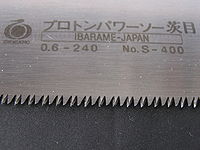
Japanese saw
Encyclopedia

Saw
A saw is a tool that uses a hard blade or wire with an abrasive edge to cut through softer materials. The cutting edge of a saw is either a serrated blade or an abrasive...
used in woodworking
Woodworking
Woodworking is the process of building, making or carving something using wood.-History:Along with stone, mud, and animal parts, wood was one of the first materials worked by early humans. Microwear analysis of the Mousterian stone tools used by the Neanderthals show that many were used to work wood...
and Japanese carpentry
Japanese carpentry
Japanese carpentry is distinguished by its advanced joinery and its finely-planed wood surfaces.-Schools of Carpentry:Though there is a core practice shared by all Japanese carpenters, defined by a vocabulary of tools and joints and a methodology of working, a carpenter will typically identify with...
that cuts on the pull stroke, unlike the Europe
Europe
Europe is, by convention, one of the world's seven continents. Comprising the westernmost peninsula of Eurasia, Europe is generally 'divided' from Asia to its east by the watershed divides of the Ural and Caucasus Mountains, the Ural River, the Caspian and Black Seas, and the waterways connecting...
an saw that cuts on the push stroke. This allows it to have thinner blades that cut more efficiently and leave a narrower cut width (kerf
Kerf
Kerf and similar can mean:* kerf, the width of a cut* Kerf, a poetry collection by Peter Sanger* Kerala E.N.T. Research Foundation , a hospital at Kollam in Kerala in India...
). On the other hand, a pull stroke does not easily permit putting one's body weight behind a stroke.
Japanese style saws have also gained popularity outside Japan.
Types of Japanese hand saws

A type of backsaw
Backsaw
A backsaw is any hand saw which has a stiffening rib on the edge opposite the cutting edge, allowing for better control and more precise cutting than with other types of saws. Backsaws are normally used in woodworking for precise work, such as cutting dovetails, mitres, or tenons in cabinetry and...
. The Japanese means "attached trunk", thus a saw with a stiffening strip attached, i.e., a backsaw.
Multi-purpose carpentry
Carpenter
A carpenter is a skilled craftsperson who works with timber to construct, install and maintain buildings, furniture, and other objects. The work, known as carpentry, may involve manual labor and work outdoors....
saw with two cutting edges. The Japanese means "double blade". There is a cross-cutting
Crosscut saw
A crosscut saw is a saw that is specially designed for making crosscuts. A crosscut is a cut made horizontally through the trunk of a standing tree, but the term also applies to cutting free lumber...
(yokobiki) blade on one side and a ripping
Rip cut
In woodworking, a rip cut is a cut made parallel to the wood grain. Rip cuts are commonly made with a table saw, but other types of saws can also be used, including hand rip saws, radial arm saws and band saws...
(tatebiki) blade on the other.
A small ryōba saw used for cutting into the flat surface of a board rather than from the edge. The blade has a convex curve which can begin the cut anywhere on the surface.
A thin saw used for cutting curves, the Japanese version of a keyhole saw
Keyhole saw
A keyhole saw is a long, narrow saw used for cutting small, often awkward features in various building materials...
. The name means "turning cut".
A saw with a disposable blade. The Japanese means "changing blade".
Other Japanese saws
- Oga
A large two-person saw used for ripping
Rip cut
In woodworking, a rip cut is a cut made parallel to the wood grain. Rip cuts are commonly made with a table saw, but other types of saws can also be used, including hand rip saws, radial arm saws and band saws...
large boards in the days before power saws. One person stood on a raised platform, with the board below him, and the other person stood underneath them.

